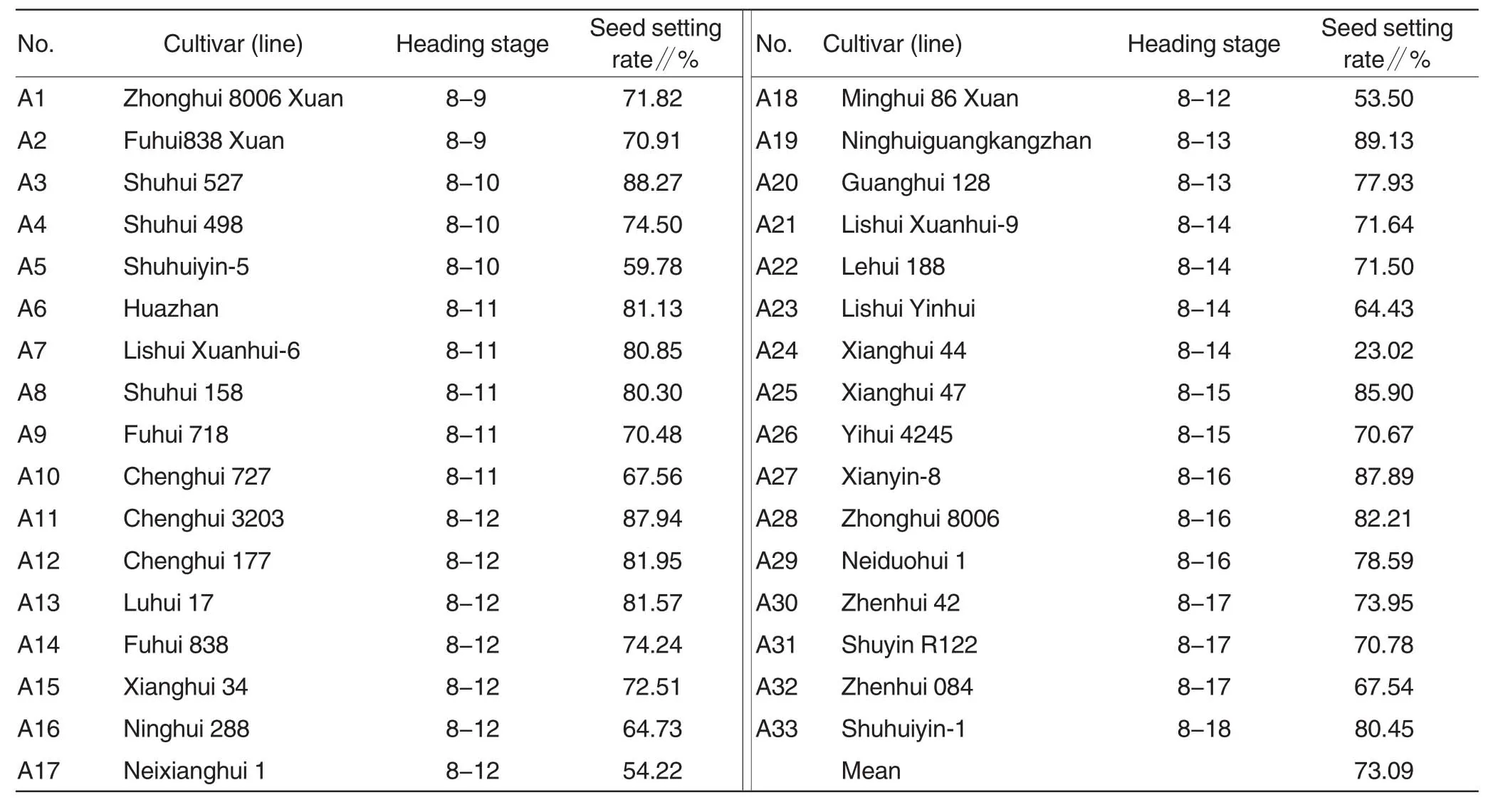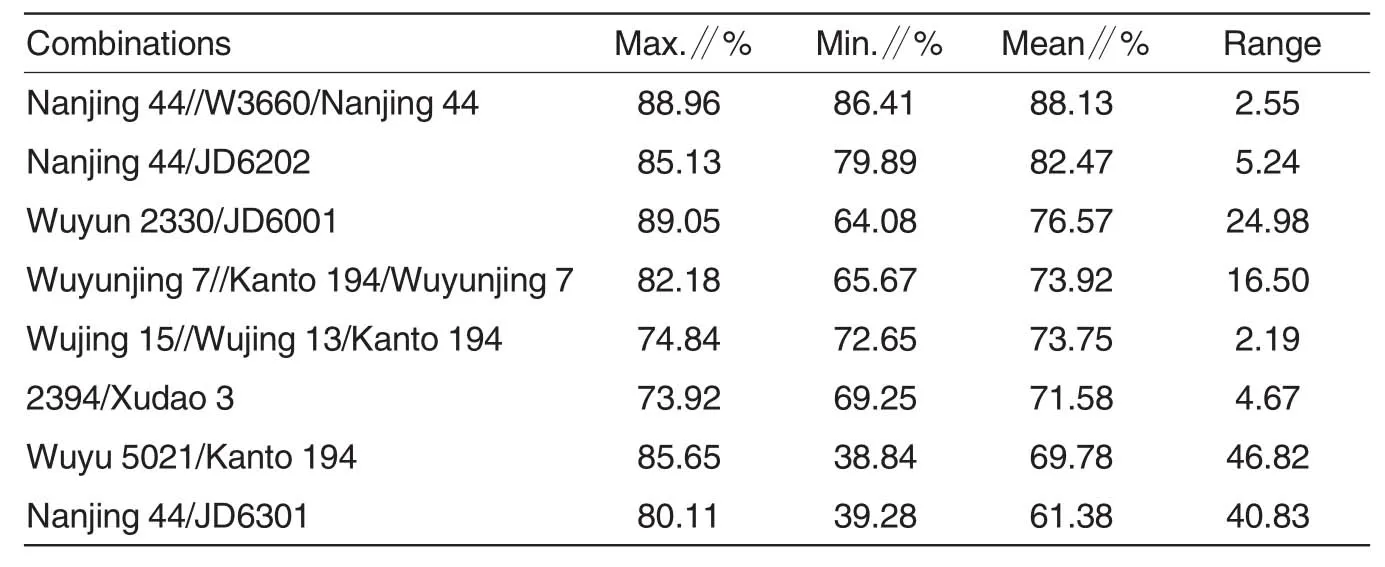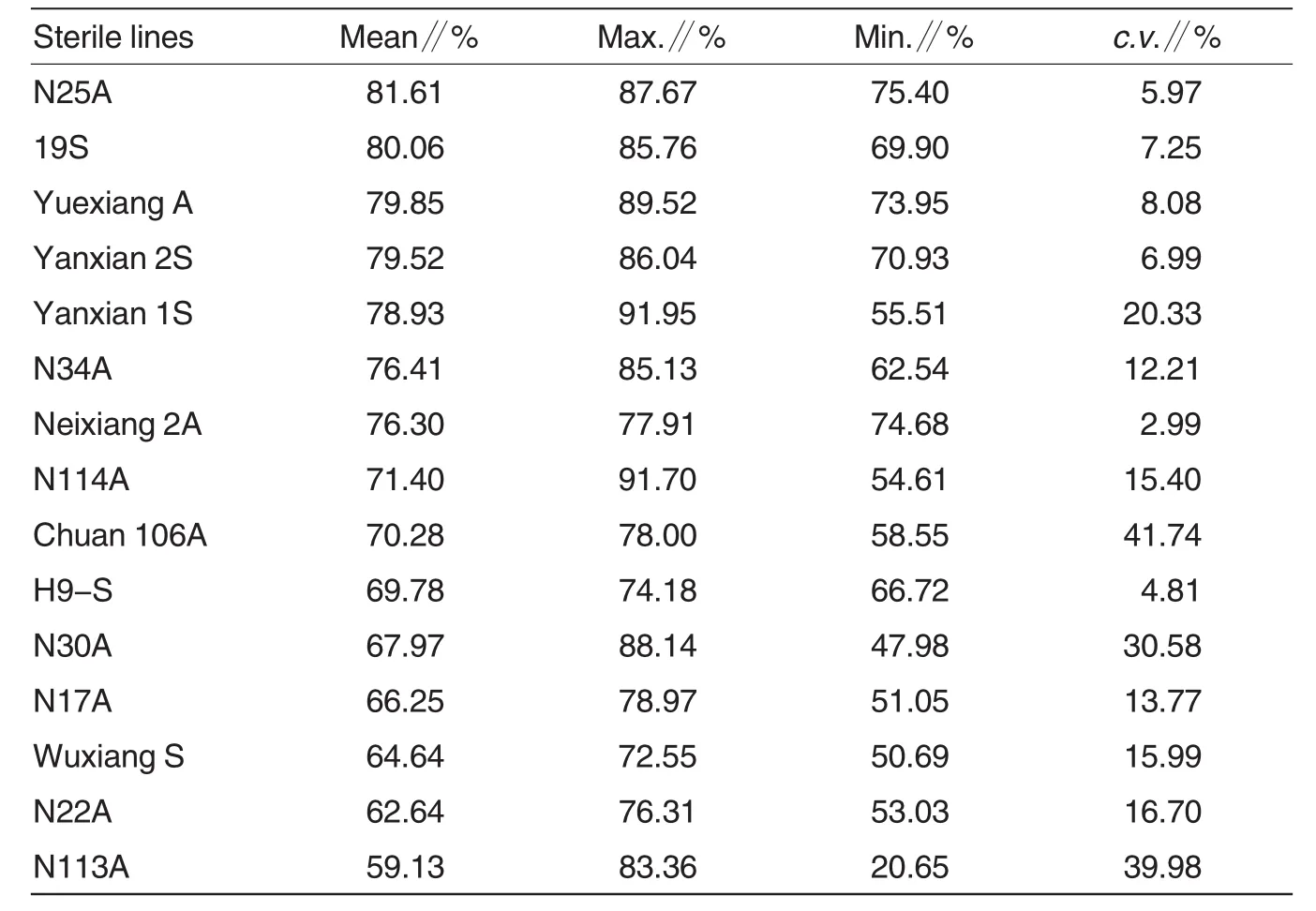Effect of Extreme Natural High Temperature on Seed Setting Rate of Rice(Oryza sativa L.)at Heading and Flowering Stage
2015-02-23ZhenZHUQingyongZHAOYadongZHANGTaoCHENShuYAOLihuiZHOUXinYUCailinWANG
Zhen ZHU,Qingyong ZHAO,Yadong ZHANG,Tao CHEN,Shu YAO,Lihui ZHOU,Xin YU,Cailin WANG
Institute of Food Crops,Jiangsu Academy of Agricultural Sciences/Jiangsu High Quality Rice R&D Center/Nanjing Branch of China National Center for Rice Improvement,Nanjing 210014,China
As climate warms,the frequency and intensity of high temperature are all increased in summer.In parts of the regions in Yangtze Ricer basin,the ridge of subtropical high pressure often shows a standstill from early and middle July to early August,which is prone to sustained high temperatures[1-2].Heat damage has become one of the major natural disasters in rice[3],seriously affecting the safety of rice production.Numerous studies[4-6]have shown that rice is most sensitive to high temperature at heading and flowering stage,and high temperature will lead to decreased seed setting rate in rice,ultimately leading to reduced yield.The main reason for reduced rice yield by high temperature is to hinder the pollen maturity and anther dehiscence,as well as the germination of pollens on stigmas and elongation ofpollen tubes.Eventually,pollination failure and infertility are induced.However,the quantitative analysis on the effect of high temperature on seed setting rate is mostly carried out under the condition of artificial high temperature.There are rare researches on the effect of extreme natural high temperature on seed setting rate of rice.In this study,the rice canopies were shown for several consecutive days in 2013,and during that time,the daily highest temperatures all exceeded 35℃.The effects of extreme natural high temperature on seed setting rates of different rice cultivars(lines)at heading and flowering stage were investigated by making full use of the favorable conditions above,and several heat-resistant materials were preliminarily screened.
Materials and Methods
Materials
The 198 new rice cultivars(lines)and combinations were introduced and bred by the Institute of Food Crops,Jiangsu Academy of Agricultural Sciences,including 33 conventionalindicarestorer lines(A1-A33),66 new conventionaljaponicacultivars(lines)(B1-B66)and 99indicahybrids.
Methods
All the tested materials were cultivated in the experimental fields of the Institute of Food Crops,Jiangsu Academy of Agricultural Sciences in 2013,and their field management was all the same.For each of the tested materials,the firstly appeared 10 panicles were labeled,and after the maturity,their seed setting rates were surveyed.The data were processed and analyzed using Excel.For the correlation analysis,arcsine transformation was carried out for the data about seed setting rates.The daily highest temperature in the rice canopy layer was detected using temperature and humidity monitor(HOBO U23-001 model).
Results and Analysis
Temporal distribution of heading stages of tested rice materials and daily highest temperatures
The daily highest temperatures from July 21 to August 30 were shown in Fig.1.The instant temperatures in the rice canopy layer were recorded very one hour by the temperature and humidity monitor.For the 13 consecutive days from August 6 to August 18,the daily highest temperatures were all higher than 36℃,which was rarely shown in the past 40 years.During that period,the temperature was highest on August 12 (38.73℃),and was lowest on August 16(36.25℃).Fig.2 showed the temporal distribution of heading stages of the 198 tested materials from August 6 to August 18.In the heading and flowering stage,all the tested materials suffered at least one day of heat stress(>36℃).
Effects of high temperature on seed setting rates of conventional indica restorer lines
The seed setting rates of the 33 conventionalindicarestorer lines under heat stress at heading and flowering stage were shown in Table 1 and Table 2.Their heading stages were during August 9 and August 18 and average seed setting rate was 73.09%,which was significantly lower than those of normal materials.The seed setting rates (ranging from 23.02%to 89.13%)of the 33 conventional indica restorer lines ranged from 23.02%to 89.13%with variation coefficient of 17.56%.There were 5 restorer lines of which the seed setting rates were higher than 85%and close to the normal level,indicating weaker effects of high temperature;there were 4 restorer lines of which the seed setting rates were lower than 60%(the lowest was 23.02%)and significantly lower than the normallevel, indicating greater effects of high temperature;the seed setting rates of most the tested materials ranged from 60%to 85%and were a littler lower than the normal level,indicating certain effects of high temperature.It indicated that the sustained high temperature had certain effects on the 33indicarestorer lines,and there were significant differences among different cultivars(lines).The seed setting rates of Ninghuiguangkangzhan (89.13%),Shuhui 527(88.27%),Chenghui 3203(87.94%)and Xianyin-8 (87.89%)were close to the normal level(90%).The correlation analysis showed that the seed setting rates of the 33 conventionalindicarestorer lines were negatively related to daily highest temperatures(y=-0.651 7x+86.996(n=33),r=0.066).

Table 1 Statistical analysis of seed setting rates of tested rice materials

Table 2 Seed setting rates of 33 conventional indica restorer lines
Effects of high temperature on seed setting rates of new conventional japonica cultivars(lines)
The average seed setting rate of the 66 new conventionaljaponicacultivars (lines)under heat stress was 70.59%with range of 32.78%-89.05%and variation coefficient of 19.91%(Table 1).As shown in Table 3,there were 21 tested materials of which the seed setting rates were lower than 65%,accounting for 31.81%of the total tested rice materials,and they were greatly affected by extreme natural high temperature;the seed setting rates of most(34)of the tested materials ranged from 70%to 85%,accounting for 51.52%of the total tested materials,and the high temperature show certain effects on them;there were 7 materials of which the seed setting rates ranged from 85%to 90%and were close to the normal level,and they were weakly affected by the high temperature.The seed setting rates of Wuyinjinghui(B2),Nanjing 44//W3660/Nanjing 44(B11),Nanjing 44//W3660/Nanjing 44 (B12)and Wuyun 2330/JD6011(B22)all approached the normal level.The correlation analysis showed that the seed setting rates of the 66 new conventional japonica cultivars(lines)were negatively related to daily highest temperatures(y=-1.756 2x+127.58(n=66);r=0.117).
The intermediate cultivars(lines)were classified statistically according to combinations.As shown in Table 3,the average seed setting rate of all the cultivars(lines)of Nanjing 44//W3660/Nanjing 44 was highest(88.13%),and among them,the lowest seed setting rate also exceeded 85%.They were affected most weakly by the extreme natural high temperature.The average seed setting rate of all the cultivars (lines)of Nanjing 44/JD6202 ranked second (82.47%)with range of 79.89%-85.13%.The heat stress showed relatively weak effect on them.There were great differences in seed setting rate among the cultivars(lines)of Wuyun 2330/JD6011,Wuyunjing 7//Kanto 194/Wuyunjing 7,Wuyu 5021/Kanto 194 and Nanjing 44/JD6301,and the effects of extreme natural high temperature also differed significantly among their cultivars(lines).The differences in seed setting rate among the cultivars (lines)of Wujing 15//Wujing 13/Kanto 194 and 2394/Xudao 3 were smaller,but the heat stress showed greateffects on alltheircultivars(lines).It indicated that combination has great influence on the heat resistance of new conventionaljaponicacultivars(lines).

Table 3 Seed setting rates of hybrids derived from different combinations

Table 4 Comparison of seed setting rates among F1hybrids derived from the same sterile lines
Effects of high temperature on seed setting rates of indica hybrids
The average seed setting rate of the 99indicaF1hybrids was 72.84%with range of 20.65%-91.95%and variation coefficient of 16.99%(Table 1).Fig.4 showed that there were 20 tested materials of which the seed setting rates were lower than 65%,accounting for 20.2%of the total tested materials,and they were greatly affected by the high temperature.There were 18 materials of which the seed setting rates ranged from 80%to 85%,accounting for 18.18%,and they were weakly affected by heat stress.There were 13 materials whose seed setting rates were higher than 85%,accounting for 13.13%of the total tested materials.Their seed setting rates were most close to the normal level(90%).There were 48 materials of which the seed setting rates ranged from 65%to 80%,accounting for 48.48%of the total materials.They were affected by the extreme natural high temperature to some extent.
The F1hybrids were classified according to sterile lines (Table 4).The seed setting rates of F1hybrids derived from N25A,19S,Yuexiang A and Yanxian 2S were relatively high with average seed setting rate of about 80%.Their seed setting rates were relatively stable among different F1hybrids with variation coefficients of 5.97%,7.25%,8.08%and 6.99%,respectively.The extreme natural high temperature showed relatively weak effects on them.The average seed setting rate of F1hybrids derived from Yanxian 1S was close to 80%,but the variation range (55.51%-91.95%)of seed setting rates was relatively large.The seed setting rates of F1hybrids derived from N113A,N22A and Wuxiang S were relatively low with average seed setting rate lower than 65%.There were great differences in seed setting rate among different combinations.The sterile line showed certain effect on heat resistance of F1hybrids.
The seed setting rates of F1hybrids derived from different restorer lines were analyzed statistically(Table 5).There were great differences in seed setting rates among F1hybrids derived from different restorer liens.The average seed setting rates of F1hybrids derived from the 24 restorer lines ranged from 53.32%to 89.00%with variation coefficients ranging from 0.9%to 39.29%.The average seed setting rates of F1hybrids derived from Xianyin-8 and Ninghuiguangkangzhan all exceeded 85%.Comparative analysis of seed setting rate was carried out between F1hybrids and their restorer lines.The results showed that the seed setting rates of most F1hybrids derived from restorer lines with good heat resistance were relatively high,but there were also some restorer lines whose F1hybrids were affected greatly by heat stress,such as Zhonghui 8006 and Shuhui 158.The seed setting rates of Zhonghui 8006 and Shuhui 158 were 82.21%and 80.30%,and theywere affected weakly by the extreme natural high temperature.However,the lowest seed setting rate among F1hybrids derived from Zhonghui 8006 was only 44.74%,and derived from Shuhui 158 was only 41.19%;their F1hybrids were all affect greatly by the heat stress.Similarly,there were also some heatsensitive restorer lines whose F1hybrids were weakly affected by the high temperature,such as Neixianghui 1,Chenghui 727 and Zhenhui 084.The seed setting rates of the three restorer lineswere54.22%,67.56% and 67.54%,respectively,but the highest seed setting rates among their F1hybridswere89.52%,89.43% and 87.67%,which were close to the normal level.The correlation analysis(Fig.5)showed that under heat stress,the seed setting rates of F1hybrids were positively related to those of their restorer lines(r=0.470*(n=24)).

Table 5 Comparison of seed setting rates among F1hybrids derived from the same restorer lines
Conclusions and Discussion
Previous studies[7-9]have shown that rice is most sensitive to high temperature before the flowering of spikelets,and heat damage at heading and flowering stage is prone to leading to greatly increased percentage of empty grains and decreased seed setting rate,ultimately leading to reduced yield.There have been some researches on critical temperature for heat damage in rice at flowering stage.It is generally considered that the critical temperature for heat damage in rice at flowering stage is 35℃.The International Rice Research Institute ever treated total 84 rice lines with temperatures of 35 and 38℃,respectively,and the seed setting rates of about 75%of the selected lines were lower than 20%under the temperature of 38℃.Therefore,35℃is considered to be more preferable for heat stress[10].The Shanghai Institute of Plant Physiology treated Erjiuqing with different high temperatures at flowering stage in artificial climate chamber.They found that the 5-consecutive-d treatment of 30℃showed significant damage to the flowering and fruiting of Erjiuqing,and the 5-consecutive-d treatment of 38℃made Erjiuqing harvest failure.Therefore,they believed that the critical temperature for longterm heat damage to indica rice was 30℃at flowering stage,and for shortterm heat damage was 35℃[11].Renet al.[12]found that hybrid rice was most sensitive to high temperature at flowering stage;the critical daily average temperature for heat damage was 30℃,and the critical daily highest temperature was 35℃.Tanet al.treated the daily average temperature of 30℃and daily highest temperature of 35℃as the critical temperatures for heat damage caused by natural high temperature[13].Tanget al.[14]found that the seed setting rates of both hybrid rice and conventionaljaponicarice were all reduced after 1-d treatment of 35℃at the heading stage.In this study,the heading stages of the tested materials were during August 6 to August 18.During the interval,the daily highest temperatures in the rice canopy layer were all higher than 36℃,and the tested materials all suffered at least one day of heat stress (36℃),basically meeting the requirements by heat damage test.
Zeng and Huanget al.found that there were great differences in heat resistance among different rice cultivars[15-16].In this study,the average seed setting rates of the three types of rice were all lower than the normal level,and significant differences were found in heat resistance among different materials,which were basically consistent with previous study results.The correlation analysis showed that the seed setting rates of both conventionalindicarestorer lines and conventionaljaponicacultivars (lines)under heat stress were all negatively related to daily highest temperature(P>0.05).Leiet al.[17]investigated the effects of natural and artificial high temperatures on seed setting rates of rice combinations and their restorer lines.The results showed that there were great differences in seed setting rate among different combinations,and the heat resistance capacities of rice combinations were linearly related to the heat resistance capacities of their male parents (P<0.05).This study found that parents had certain effects on the heat resistance capacities of their F1hybrids.The seed setting rates of most the F1hybrids derived from restorer lines with good heat resistance were higher,but there were also some F1hybrids affected greatly by high temperature.Some of the F1hybrids derived from restorer lines with bad heat resistance were affected weakly by heat stress.The correlation analysis showed that under heat stress,the seed setting rates of F1hybrids were positively related to those of their restorer lines.
High temperature is a natural disaster,and is irresistible.The heat damagecanonlybereduced or avoided by active defensive measures.From the perspective of cultivation,reasonable arrangement of sowing period is an effective measure to avoid heat damage.The arrangement of sowing period should follow the principles that heading stage avoids high temperature in hot summer,heading is completed before the safe full heading stage,and the sowing of next-season crop is not affected.Studies have shown that there are greatdifferences in sensitivity to high temperature among different cultivars.In terms of species,the selection of heat-tolerant cultivars can effectively reduce heat damage.Moreover,parents have a significant impact on heat resistance oftheir future offspring.So the screening of heat-tolerant resources plays an important role in breeding of heat-tolerantcultivars.There have been many studies on screening of heat-tolerant resources[18-20].A group of heat-tolerantresources have been screened out,but most of them are local cultivars,of which the agronomic traits are poor and cannot be utilized directly.In this study,total 4 conventionaljaponicacultivars and 4 conventionalindicarestorer lines are preliminarily screened out,and they are all new cultivars (lines)with better agronomic traits after generations of selection.After the heat resistances are identified repeatedly and confirmed,the screened cultivars (lines)can directly used in production or as heat-tolerant resources.
[1]WU XZ(吴宪章),LI L(李林),LI LP(李路平).Terroir environment and planting division of rice-growing areas in China(中国稻区的风土环境和种植区划)[M].Beijing:China Agriculture Press(北京:中国农业科技出版社),1992.
[2]WANG SQ(王世耆),CHENG YN(程延年).Crop yield and weather and climate(作物产量与天气气候)[M].Beijing:Science Press(北京:科学出版社),1991.
[3]ZHANG GL(张桂莲),CHEN LY(陈立云),LEI DY(雷东阳),et al.Progressed in research on heat tolerance in rice(水稻耐热性研究进展)[J].Hybrid Rice (杂交水稻),2005,20(1):1-5.
[4]LI WB(李文彬),WANG H(王贺),ZHANG FS(张福锁).Effects of silicon on anther dehiscence and pollen shedding in rice under high temperature stress(高温胁迫条件下硅对水稻花药开裂及授粉量的影响)[J].Acta Agronomica Sinica(作物学报),2005,31(1):134-136.
[5]GAO LZ(高亮之),LI L(李林).Rice meteorological ecology (水稻气象生态)[M].Beijing:Agriculture Press(北京:农业出版社),1992.
[6]PRASAD PVV,BOOTE KJ,ALLEN LH,et al.Species,ecotype and cultivar differences in spikelet fertility stress[J].Field Crops Research,2006,95:398-411.
[7]Shanghai Institute of Plant Physiology(上海植物生理研究所).The influence of high temperatures on flowering and fruiting of early rice III.High temperature sensitivity of flowering and fruiting of early rice (高温对早稻开花结实的影响及其防治Ⅲ.早稻开花结实对高温伤害的敏感期)[J].Acta BOtanica Sinica(植物学报),1977,19(2):126-130.
[8]LI XZ(李训贞),LIANG MZ(梁满中),ZHOU GQ(周广洽),et al.Effect of environment condition on pollen vigor and seed set during flowering time of rice(水稻开花时的环境条件对花粉活力和结实的影响)[J].Acta Agronomica Sinica(作物学报),2002,28(3):417-420.
[9]SATAKE T,YOSHID AS.High temperature induced sterility in indica rices at flowering[J].Japan Journal of Crop Science,1978,47(1):6-17.
[10]IRRI.Annual Report for 1977-1983[C].Los Banos,Philipines,1978-1984.
[11]Shanghai Institute of Plant Physiology(上海植物生理研究所).The influence of high temperatures on flowering and fruiting of early rice II.High temperature sensitively of flowering and fruiting of early rice(高温对早稻开花结实的影响及其防治Ⅱ.早稻开花期高温对开花结实的影响)[J].Acta BOtanica Sinica(植物学报),1976,18(4):323-328.
[12]REN CF(任昌福).The influence of high temperature on flowering and fertilization of hybrid rice cultivars(高温对杂交水稻开花结实的影响)[J].Journal of Southwest College of Agriculture(西南农学院学报),1984,1:25-30.
[13]TAN ZH(谭中和).Studies on high temperature injury on hybrid rice at flowering time and the strategy to avoid high temperature damage(杂交籼稻开花期高温危害及对策的研究)[J].Acta Agronomica Sinica(作物学报),1985,2:103-108.
[14]TANG RS(汤日圣),ZHENG JC(郑建初),ZHANG DD(张大栋),et al.Effects of high temperature on pollen vitality and seed setting of different rice varieties(高温对不同水稻品种花粉活力及籽粒结实的影响)[J].Jiangsu Journal of Agricultural Sciences (江苏农业学报),2006,22(4):369-373.
[15]ZENG HL(曾汉来),LU KY(卢开阳),HE HH(贺浩华),et al.The spikelet fertility of sever mid mature indica hybrid rice combinations under high temperature conditions(中籼杂交水稻新组合结实性的高温适应性鉴定)[J].Journal of Huazhong Agricultural University(华中农业大学学报),2000,19(1):1-4.
[16]HUANG JY(黄英金),LUO YF(罗永锋),HUANG XZ(黄兴作),et al.Varietal difference of heat tolerance at grain filling stage and its relationship to photosynthetic characteristics and endogenous polyamine of flag leaf in rice(水稻灌浆期耐热性的品种间差异及其与剑叶光合特性和内源多胺的关系)[J].China Journal of Rice Science(中国水稻科学),1999,13(4):205-211.
[17]LEI DY(雷东阳),CHEN LY(陈立云),LI WX(李稳香),et al.Effects of high temperature in flowering stage of hybrid rice on seed set and its related physiological characteristics (杂交水稻抽穗扬花期高温对结实率及相关生理特性的影响)[J].Hybrid Rice (杂交水稻),2006,21(3):68-71.
[18]JAGADISH SVK,CRAUFURD PQ,WHEELER TR.Hightemperature stress and spikelet fertility in rice(Oryza sativaL.)[J].J ExpBot,2007,58(7):1627-1635.
[19]LI TG(李太贵),SHEN B(沈波).Identification of heat resistance in rice cultivars at flowering stage(水稻品种开花期抗热性鉴定研究)[J].Zuowu Pinzhong Ziyuan (作物品种资源),1995,1:34-35.
[20]JAGADISH SVK,CRAUFURD PQ,WHEELER TR.Phenotyping parents of mapping populations of rice for heat tolerance during anthesis[J].Crop Science,2008,48(3):1140.
猜你喜欢
杂志排行
Agricultural Science & Technology的其它文章
- Study on Effects of Calcium on Photosynthetic Characteristics and Its Subcellular Distribution in Rice at Seeding Stage
- The Breeding of Hybrid Rape Variety Youyan 924 with Strong Heterosis and High Oil
- Effects of Bamboo Vinegar on Seed Germination and Seedling Growth of Different Flue-cured Tobacco Varieties
- Comprehensive Evaluation on Drought Tolerance of Widely-used Rice Varieties with Subordinate Function Method
- Analysis on Tissue-specific Expression of DpXTH1 and DpXTH2 Genes in Dahlia
- Selection of Third-party Logistics Provider for Agricultural Products Based on System Comprehensive Evaluation
